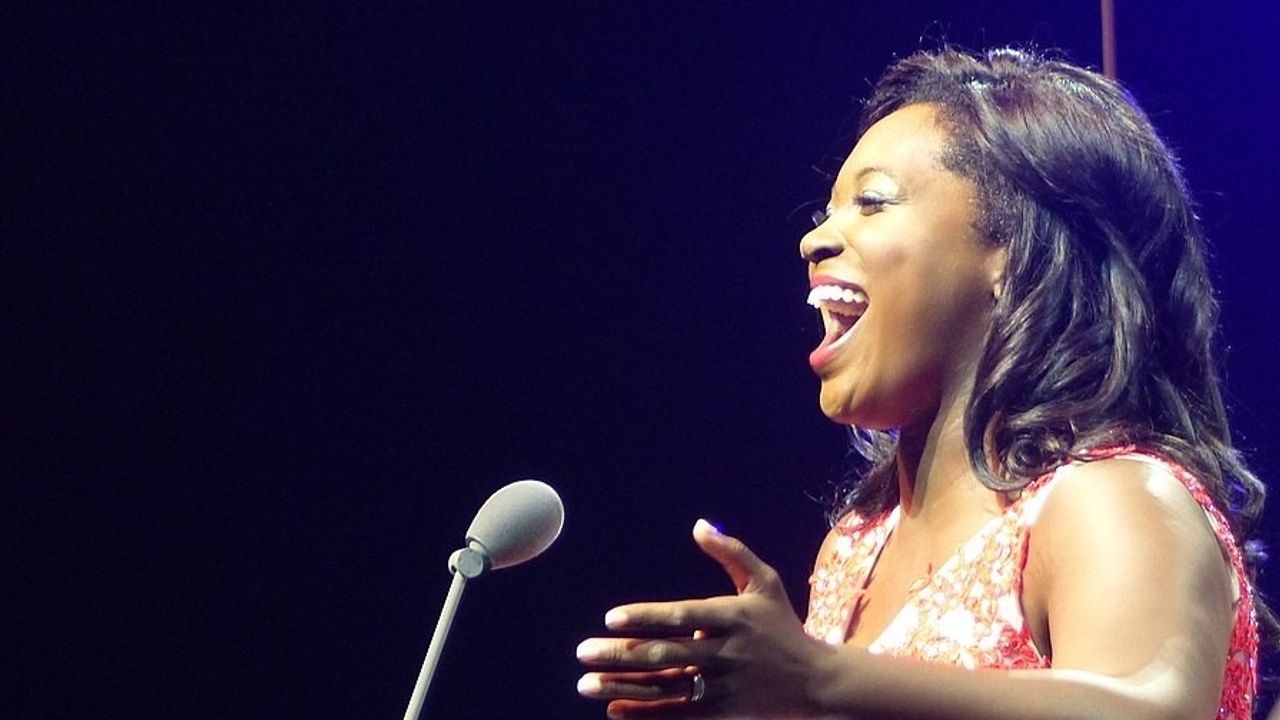Opera: Suffering as Entertainment

Soprano Angel Blue
Here’s a story: A young black woman is kidnapped, held hostage, and humiliated. There’s a ray of hope when one of her captors’ employees betrays them in the hope of absconding with her. But he’s caught, and they both die.
This, of course, is the plot of Verdi’s Aida, considered by many to be the grandest of all grand operas. Outsized emotions are what make grand opera grand, so the greater the suffering and hope portrayed, the more cathartic the opera will be for the audience. Beginning with Aida’s premiere, opera companies have traditionally heightened the grandeur of the protagonist’s emotions with the most epic production values imaginable:
At “Aida’s” 1871 world premiere in Cairo, 12 elephants joined a double chorus in the scene welcoming a brave soldier’s return from battle. In Shanghai’s uber-performance of the Verdi classic in 2000, the elephants had even more company: camels, lions, tigers, boas, horses and parrots, not to mention 3,000 singers, dancers, acrobats and behind-the-scenes technicians.
Source: LA Times
Aida is far from the only opera inspired by the story of a suffering, marginalized woman. Of the ten most frequently performed operas, six center on title characters who are marginalized women:
- Mimì, aka La Bohème, is desperately poor and cannot afford treatment for the tuberculosis that will kill her at the end of the opera.
- Tosca has the misfortune to love a political dissident. She escapes a brutal rape at the hands of her lover’s persecutor by murdering him, only to leap to her death when she is caught.
- Carmen is the cautionary tale of a woman who pursues the sexual freedom reserved for men and must therefore be murdered by an entitled soldier whom she no longer desires.
- Violetta, aka La Traviata (often translated into English as The Fallen Woman), is a high-end sex worker whose major health issues are exacerbated by the demands of her profession. She is loved by a young man of privilege who seeks to care for and protect her, but his father puts an end to their relationship in order to preserve his family’s good name. She returns to her old life and, predictably, dies.
- Cio-Cio-San, aka Madama Butterfly, is a fifteen-year-old Japanese sex worker who is rented out to keep house for and meet the sexual and companionship needs of a white U.S. Navy lieutenant. He lets her think they’ll be together forever but abandons her, returning only to steal the child she has borne him. She kills herself.
- Aida is the aforementioned enslaved young black woman, abducted from the homeland she will never see again, buried alive with a man who led a massive military campaign against her people.
Six out of ten of the most frequently performed operas. Take a moment to let that sink in.
By the way, the two operas with male title characters that made the top ten list feature notorious rapists Don Giovanni and the Duke of Mantua (and title character Rigoletto is himself no peach).

Before I get into why opera audiences love ourselves some suffering, allow me to be perfectly clear: I am in no way encouraging the “cancellation” of any of these works. I love all of them.
But I find it highly problematic that most of the wealthy, privileged, predominantly white people who populate opera’s administrations, boards, donor base, and audiences care nothing about the plight of the real women whose stories align with these six title characters.
How many Mimìs die every day for want of healthcare?
How many Toscas are imprisoned or die when they resort to violence against a rapist?
How many Carmens are violently targeted by incels with easy access to guns?
How many Violettas are socially shamed and shunned as sex workers?
How many underage Cio-Cio-Sans are misled, pimped out, and abandoned by their seducers?
How many Aidas are trafficked and humiliated by captors pursuing the genocide of their people?
In case there are any sea lions among you who feel moved to point out that Aida wasn’t technically trafficked, or that Cio-Cio-San wasn’t exactly pimped out, please save your pixels, unless you can offer proof that you actually care about and advocate for real-life victims of trafficking and forced prostitution. It isn’t my point to draw perfect parallels.
My point is that opera farms the intense, dramatic lives of marginalized, suffering women for stories that will move audiences to tears, while seeming to ignore the actual suffering of the kinds of marginalized women who were the inspiration for these stories.

Why do opera audiences love ourselves some suffering?
Nine years ago I touched on the answer in a blog post:
Opera draws on the most heightened, complex human situations possible in order to expand the listener’s capacity to feel. So much in our world conspires to obscure genuine desires and feelings. We’re bombarded with powerful messages about how we should look, what we should eat, what kinds of relationships we ought to have, and what careers to pursue… By contrast, the practice of singing puts us [and by transference, our listeners] in touch with our desires and feelings and empowers us to express them.
Our death denying, competitive, judgmental, scarcity-minded culture daily gives all of us reason to feel terrified, enraged, hopeless, and marginalized—and then exhorts us to Keep Calm And… whatever. Privilege may offer protection against violence and financial despair, but it cannot shield anyone from the terror of a poorly-managed pandemic, the anguish of a failed marriage, the rage of a losing battle with cancer, and so on. In our culture, generally speaking, the greater one’s privilege, the greater the exhortation to keep one’s feelings to oneself.
I believe that humans are by nature vibrant, passionate, feeling creatures, and the way we are conditioned to keep our feelings bottled up is very, very bad for us. So we are always seeking permissible outlets for our feelings, and the opera house is the perfect place for people of privilege to sit quietly in the dark, open their hearts wide, and let the music clean them out. As I wrote in my earlier blog post, “The naked human voice sets listeners’ auditory apparatuses in motion, creating a sympathetic vibratory connection that exhorts them to feel what the singer is feeling at that moment. It’s an experience of visceral, as opposed to virtual, reality. It is a potentially ecstatic, cathartic experience of inestimable value.”
The bigger the emotions, the more powerful the catharsis.
The more marginalized and suffering the protagonist, the bigger the emotions.
The more privileged and feeling-starved the audience member, the less likely they are to relate to those for whom such suffering represents not entertainment, but rather their ongoing lived experience.

I was motivated to write this post by recent events at the Arena di Verona. A brief summary:
- White celebrity diva and racist Anna Netrebko proudly performed Aida for Verona in blackface;
- Black soprano and advocate Angel Blue subsequently withdrew from Verona’s production of La Traviata in protest.
- The fallout for Ms. Blue’s courageous withdrawal is ongoing as I type, and I wish her all possible support from the community. Please show her some love, in any way you can think to. I imagine that her manager can receive mail and messages on her behalf.
You, my readers, are mostly singers and those who support singers’ wellness and development. I am writing this because I want all of us to think long and hard about the disparity between the spectacular glorification of marginalized women in opera productions, and the way the opera community gravely fails to support marginalized populations in real life.
Use your voice to encourage the platforming of singers representing marginalized communities. Who better to give voice to these iconic, tragic roles than those whose lived experiences have immediate resonance with their stories?
Take every opportunity to encourage opera companies to pair productions of these works with incentives to support communities afflicted by the types of suffering they show on the stage. Ask them to help audiences make the connection between Mimì and her contemporary sisters, and to raise awareness and resources for these real suffering women.
Let’s also check ourselves. Twenty years ago, this white girl sang Cio-Cio-San in full geisha drag, and had a gorgeously cathartic time immersed in joy, longing, and lethal despair of it all. It never occurred to me (or anyone else on the production, or any other production in the early aughts) to consider how harmful and insulting it is to cosplay a racial minority.
And should you find yourself with the opportunity to embody one of these iconic roles, use your platform and privilege to educate everyone around you about the real suffering and needs of the real marginalized women your character represents.
If you enjoyed this post and would like a heads up when I post new content, please subscribe to my newsletter.


